You’ve got a balcony and a love for gardening, but keeping your pets safe is key. Begin by evaluating risks like toxic plants or unstable pots that could harm your furry friends. Think about a 3-foot-high barrier or non-toxic marigolds to start. How do you balance beauty with safety? Stick around to uncover practical steps for a secure, vibrant space.

Contents
- 1 Understanding Pet Risks in Balcony Gardens
- 2 Selecting Non-Toxic Plants for Your Space
- 3 Avoiding Harmful Fertilizers and Chemicals
- 4 Securing Planters to Prevent Accidents
- 5 Creating Barriers for Pet Safety
- 6 Choosing Safe Mulching Materials
- 7 Positioning Plants Out of Reach
- 8 Monitoring Watering Systems for Hazards
- 9 Incorporating Pet-Friendly Garden Features
- 10 Checking for Toxic Pollen and Seeds
- 11 Maintaining a Clean Garden Area
- 12 Training Pets to Avoid Certain Spots
- 13 Using Raised Beds for Added Protection
- 14 Inspecting for Hidden Dangers Regularly
- 15 Balancing Beauty and Safety in Design
Understanding Pet Risks in Balcony Gardens
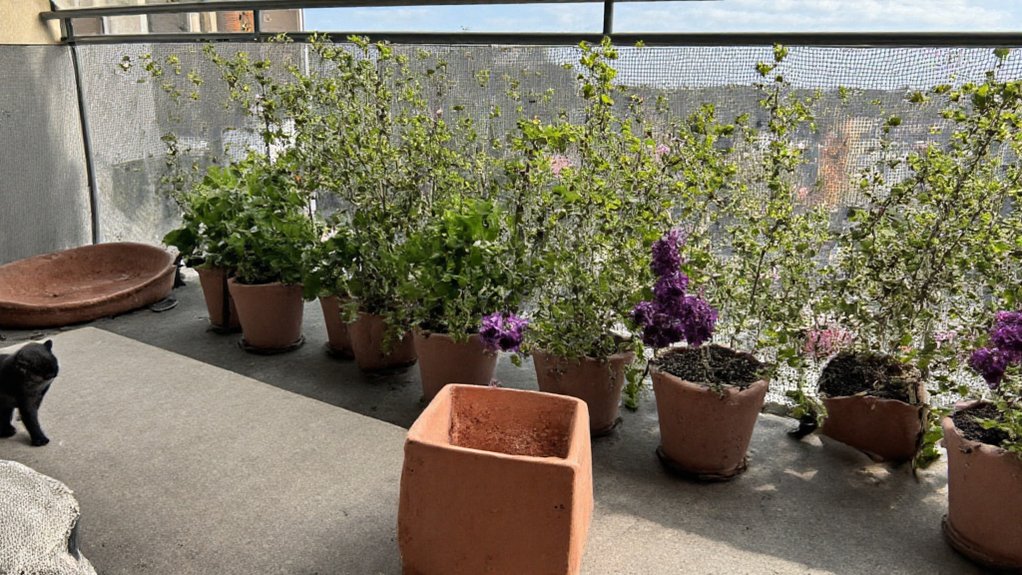
When creating a balcony flower garden, it’s essential to understand the potential risks to pets that may have access to the space. Many common plants, such as lilies, azaleas, and sago palms, are toxic to cats and dogs if ingested, potentially causing symptoms ranging from mild gastrointestinal upset to severe organ damage or even death. Additionally, pets may be tempted to chew on plants or dig in the soil, which can expose them to harmful fertilizers, pesticides, or sharp objects hidden in the garden.
Beyond plant toxicity, balcony gardens pose other hazards like the risk of falls if railings are not secure or if pets can climb onto elevated surfaces. Small pots or garden tools left unsecured can also become hazards if knocked over or chewed on. Being aware of these risks is the first step in designing a pet-safe balcony garden that allows both your plants and pets to thrive harmoniously.
Selecting Non-Toxic Plants for Your Space
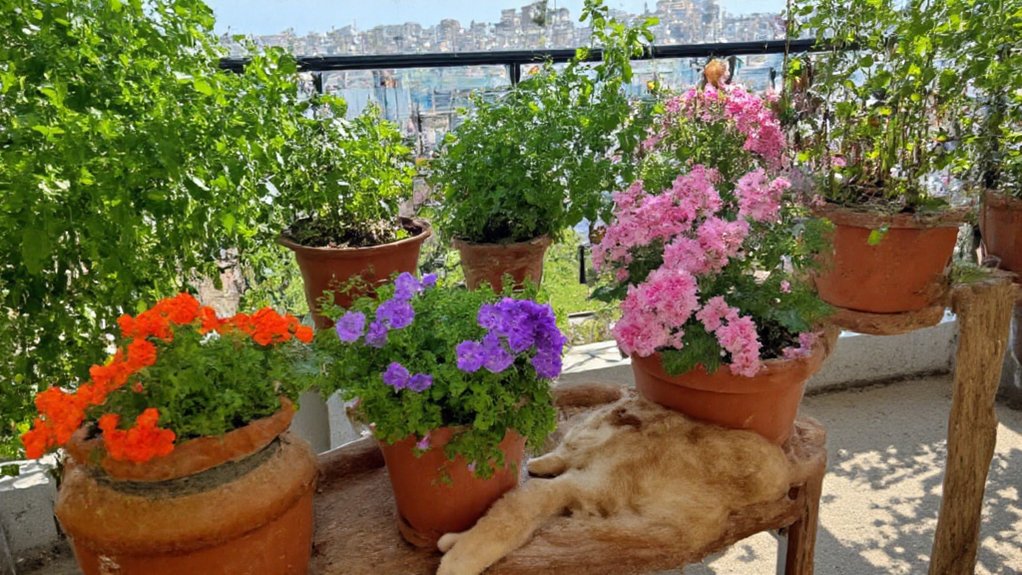
When creating a pet-safe balcony flower garden, selecting non-toxic plants is vital to guarantee the safety of your furry companions. Many common plants can be harmful to pets if ingested, causing symptoms ranging from mild gastrointestinal upset to severe toxicity. By carefully choosing plants that are safe for cats, dogs, and other animals, you can create a beautiful and worry-free outdoor space.
Start by researching plants that are known to be non-toxic, such as marigolds, petunias, and snapdragons, which add vibrant color without posing a risk. Other safe options include spider plants, Boston ferns, and certain herbs like basil or thyme, which can double as functional additions to your garden. Always cross-check with reliable resources like the ASPCA’s list of toxic and non-toxic plants to confirm your selections are safe for your specific pet.
Avoiding Harmful Fertilizers and Chemicals
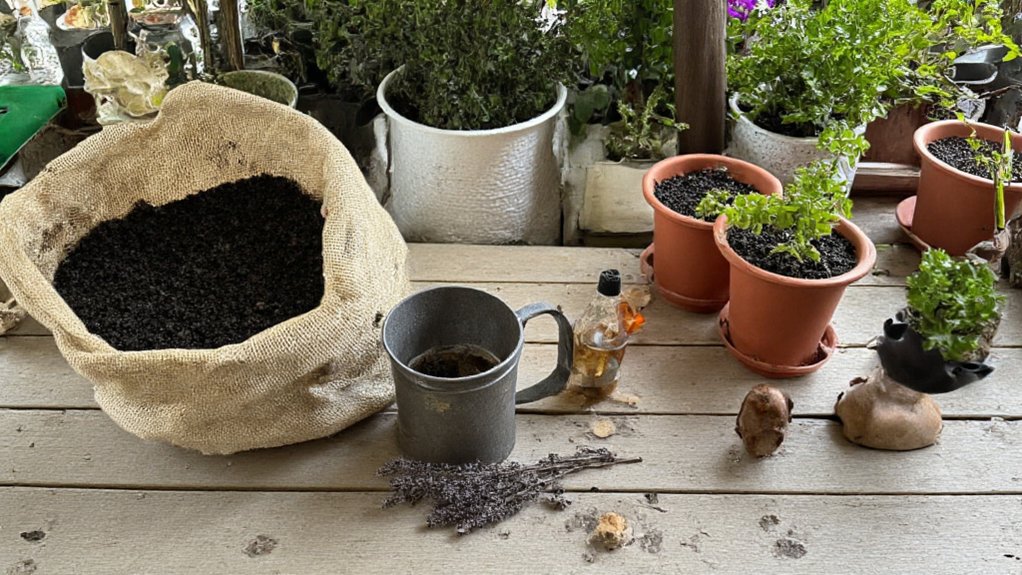
When creating a pet-safe balcony flower garden, avoiding harmful fertilizers and chemicals is vital to protect your furry companions. Many common garden products, such as synthetic fertilizers, pesticides, and herbicides, contain toxic ingredients that can be dangerous if pets ingest or come into contact with them. These chemicals may cause symptoms ranging from mild irritation to severe poisoning, so it’s essential to choose natural and pet-friendly alternatives.
Opt for organic fertilizers like compost, manure, or fish emulsion, which are less likely to harm pets. Additionally, consider natural pest control methods, such as introducing beneficial insects like ladybugs or using neem oil, which is non-toxic to animals when used properly. Always read labels carefully and store any garden products securely out of your pet’s reach to prevent accidental exposure.
Securing Planters to Prevent Accidents

Securing planters on a balcony is vital to prevent accidents, especially when pets are around. Unsecured pots or hanging baskets can easily tip over due to wind, curious pets, or accidental bumps, posing a risk of injury or damage. To guarantee safety, use heavy, stable planters that are difficult to knock over, or secure lighter ones with brackets, rail mounts, or heavy-duty adhesive strips designed for outdoor use.
Additionally, consider attaching planters to the balcony railing or wall using sturdy hooks or clamps, guaranteeing they are tightly fastened and regularly checked for stability. For hanging baskets, use strong, weather-resistant chains or ropes and double-check the weight capacity of the mounting hardware. These precautions help create a safe environment for both your pets and your garden, minimizing the risk of accidents.
Creating Barriers for Pet Safety

Creating barriers for pet safety is a vital step in designing a pet-safe balcony flower garden. Pets, especially cats and dogs, can be curious and may attempt to explore or jump over balcony edges, risking serious injury. Installing sturdy barriers, such as pet-proof netting, wire mesh, or clear plastic panels, can prevent pets from accessing dangerous areas while still allowing light and air to pass through for your plants. Make sure that the barriers are tall enough and securely fastened to withstand any attempts by your pet to climb or push through.
Additionally, consider placing heavy planters or decorative screens along the inner edge of the balcony to create a physical and visual barrier that discourages pets from getting too close to the railing. These barriers not only enhance safety but can also add to the aesthetic appeal of your garden. Always double-check for gaps or weak spots in your setup to guarantee your pet remains safe while enjoying the outdoor space with you.
Choosing Safe Mulching Materials
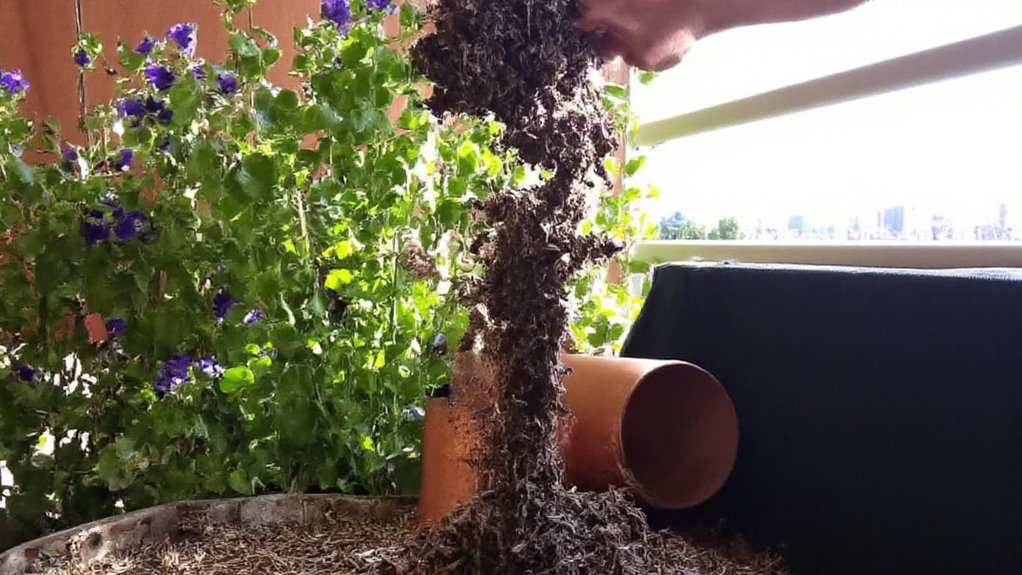
When creating a pet-safe balcony flower garden, choosing the right mulching materials is vital to guarantee the safety of your furry friends. Mulch helps retain moisture, suppress weeds, and enhance the aesthetic appeal of your garden, but some common materials can be harmful to pets if ingested or if they come into contact with them. Opt for pet-friendly options like cedar mulch, which is non-toxic and naturally repels insects, or pine bark, which is also safe and breaks down slowly to provide long-term benefits to the soil.
Avoid potentially dangerous mulching materials such as cocoa mulch, which contains theobromine—a compound toxic to dogs and cats—and rubber mulch, which can pose a choking hazard or cause intestinal blockages if chewed. Always research the materials you plan to use, and consider covering the mulch with a layer of pet-safe mesh or stones to prevent your pets from digging or accessing it directly. By selecting safe mulching materials, you can maintain a beautiful balcony garden while keeping your pets out of harm’s way.
Positioning Plants Out of Reach
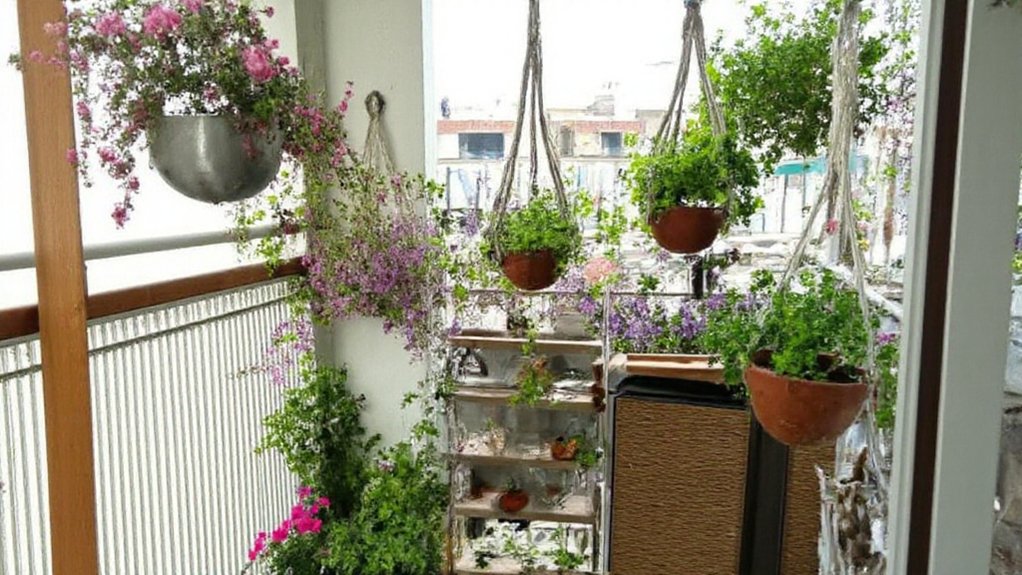
Positioning plants out of reach is an essential step in creating a pet-safe balcony flower garden. Many common balcony plants, such as ivy or petunias, can be toxic to pets if ingested, and curious cats or dogs may attempt to chew on leaves or dig in the soil. To prevent this, place plants on high shelves, hanging baskets, or wall-mounted planters that are inaccessible to your pets, ensuring they cannot jump or climb to reach them.
Additionally, consider the layout of your balcony to avoid placing pots near edges or low railings where pets might accidentally knock them over or get too close. Using sturdy barriers or decorative fencing around lower plant areas can also help keep pets at a safe distance while maintaining the aesthetic appeal of your garden.
Monitoring Watering Systems for Hazards
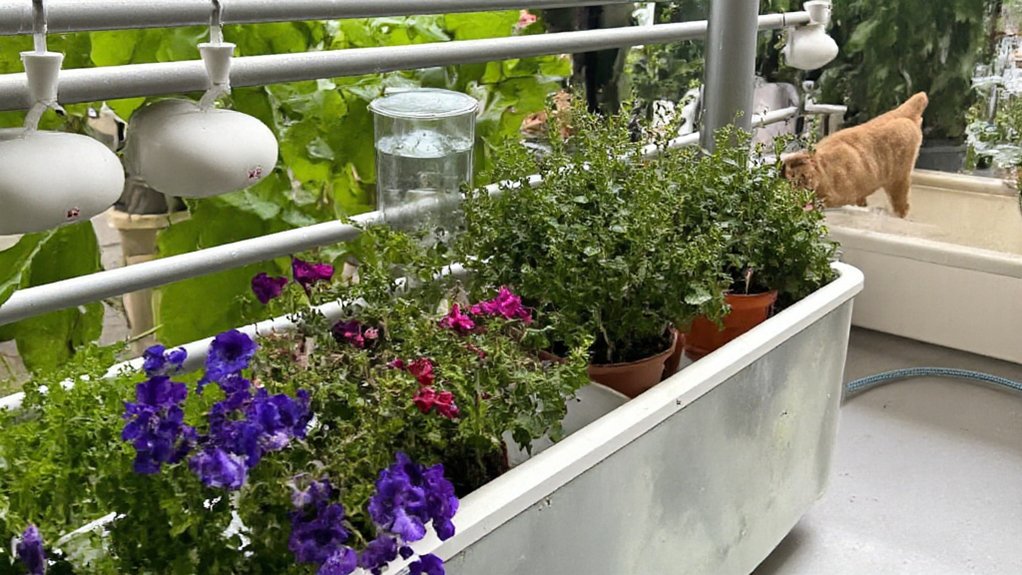
Monitoring watering systems for hazards is vital when maintaining a pet-safe balcony flower garden. Pets can be curious and may interact with irrigation setups, such as drip systems or self-watering pots, which could pose risks like drowning in water reservoirs or chewing on hoses and electrical components if automated systems are used. Regularly inspect these systems for leaks, exposed wires, or accessible water containers that could attract or endanger your pet.
Additionally, make sure that any chemicals or fertilizers mixed into the water are pet-safe and stored securely away from the watering system. Check for stagnant water in trays or pots, as it can become a breeding ground for bacteria or pests, potentially harming your pet if they drink it. By staying vigilant and addressing these hazards promptly, you can maintain a safe environment for your pets while keeping your balcony garden thriving.
Incorporating Pet-Friendly Garden Features
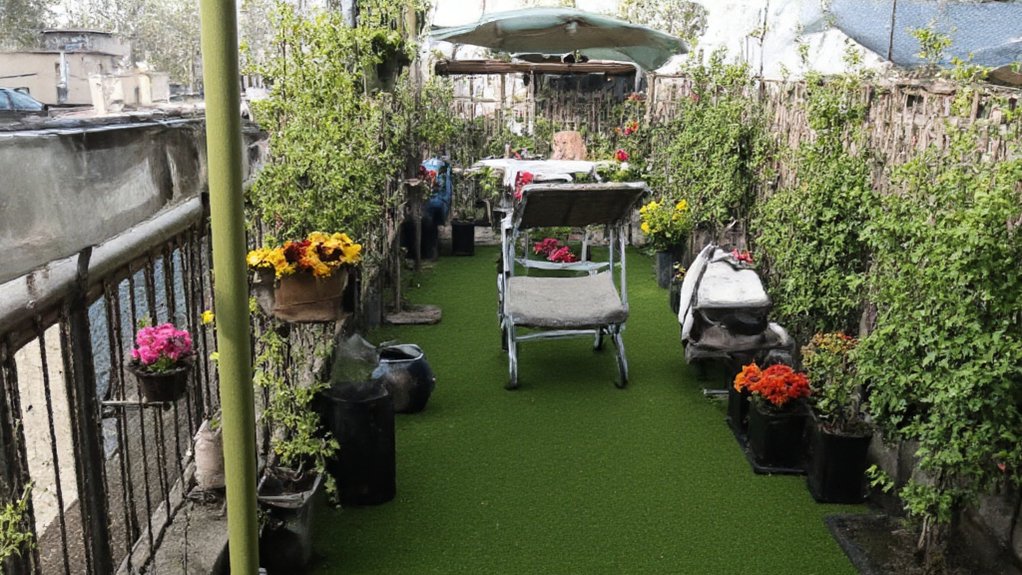
Incorporating pet-friendly garden features into a balcony flower garden is essential to guarantee the safety and enjoyment of your pets while maintaining a beautiful outdoor space. Start by choosing non-toxic plants, as many common flowers and greenery can be harmful if ingested by cats or dogs. Opt for pet-safe options like marigolds, sunflowers, or pet grass, which can provide a safe chewing alternative for pets. Additionally, secure plants in sturdy, tip-resistant containers to prevent them from being knocked over during playful antics.
Beyond plant selection, consider creating designated pet areas within the balcony garden. Lay down a small patch of artificial turf or a pet-safe mat where your pet can relax or play without disturbing the plants. Adding a shaded spot with a pet bed or a water bowl can also make the space more inviting for your furry friend. Finally, make sure that railings or barriers are secure to prevent pets from accessing unsafe edges, keeping the balcony a safe haven for both you and your pet to enjoy together.
Checking for Toxic Pollen and Seeds
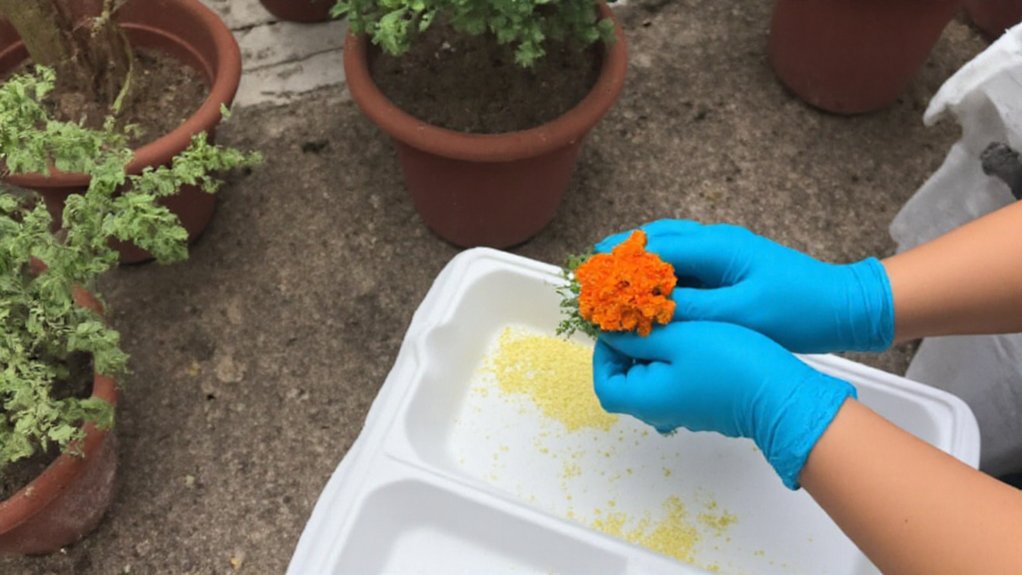
When creating a pet-safe balcony flower garden, checking for toxic pollen and seeds is a vital step to guarantee the safety of your furry companions. Many common flowers produce pollen or seeds that can be harmful if ingested by pets, potentially causing symptoms ranging from mild irritation to severe poisoning. For instance, plants like lilies are extremely toxic to cats, with even small amounts of pollen leading to kidney failure, while certain seeds from plants like sago palm can be deadly to dogs.
To protect your pets, research each plant species before adding them to your balcony garden, focusing on whether their pollen or seeds pose a risk. Resources such as the ASPCA’s toxic plant list can help identify dangerous varieties, and opting for pet-friendly alternatives like marigolds or petunias can minimize hazards. Regularly inspect your plants for fallen seeds or pollen buildup on surfaces where pets might come into contact, and clean these areas to prevent accidental exposure.
Maintaining a Clean Garden Area

Maintaining a clean garden area on your balcony is essential for both the health of your plants and the safety of your pets. Regularly sweep or remove fallen leaves, petals, and debris to prevent mold growth and discourage pests that could harm your plants or attract your pets to dig or chew. Keeping the area tidy also reduces the risk of your pet ingesting harmful materials or getting injured by sharp objects hidden in the mess.
Additionally, clean up any spilled soil or water immediately to avoid slippery surfaces or potential messes that could track into your home. Use pet-safe cleaning products if you need to wash down the balcony, as harsh chemicals can be toxic to animals. By maintaining a clean space, you create a safer and more enjoyable environment for both you and your furry companions to enjoy the balcony garden.
Training Pets to Avoid Certain Spots
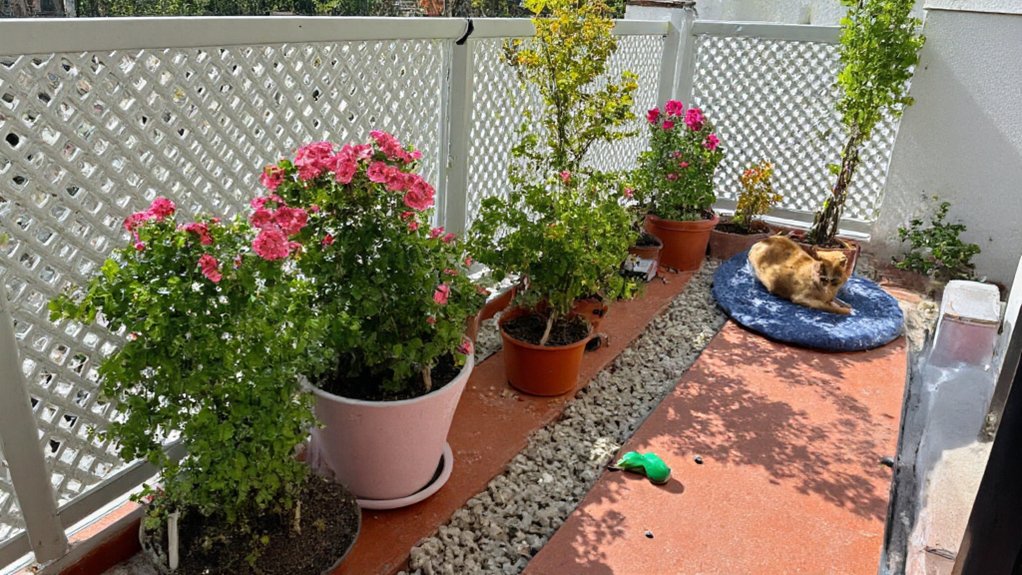
Training pets to avoid certain spots in a balcony flower garden is an essential step to guarantee their safety and protect your plants. Start by setting clear boundaries using physical barriers like small fences or decorative rocks around areas you want to keep off-limits. Consistently redirect your pet away from these spots by guiding them to designated pet-friendly areas, such as a corner with their toys or a comfy mat, and reward them with treats or praise for staying there.
Additionally, use deterrents like pet-safe bitter sprays on plants or areas you want to protect, as the unpleasant taste can discourage pets from exploring. Supervise your pet during initial training sessions to correct unwanted behavior immediately, and be patient as they learn the rules. Over time, with consistent reinforcement, most pets will understand which areas are off-limits and adapt to enjoying the balcony safely.
Using Raised Beds for Added Protection
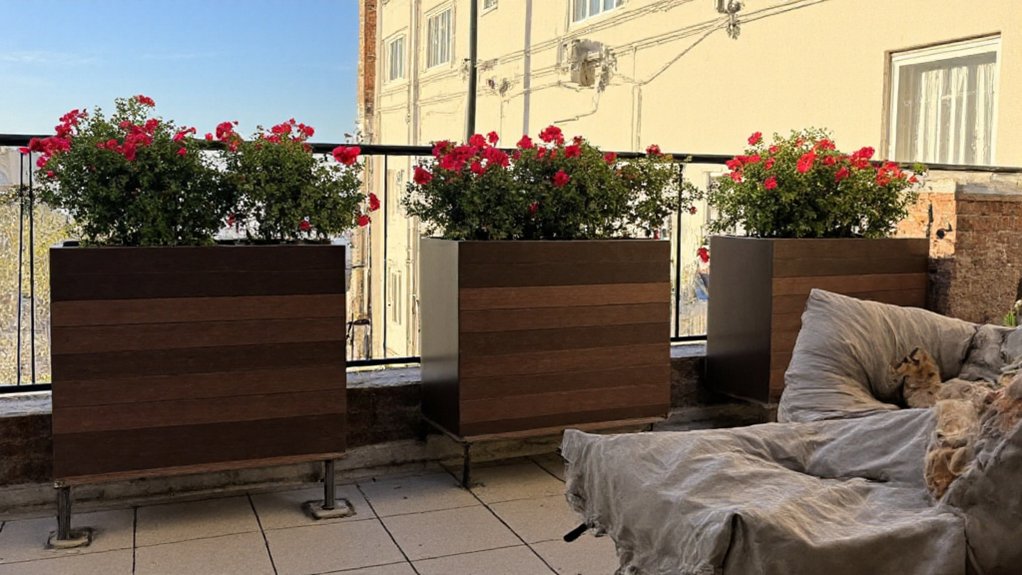
Using raised beds for a pet-safe balcony flower garden offers an additional layer of protection for your furry friends. These elevated structures keep plants out of reach, reducing the risk of pets nibbling on potentially toxic flowers or digging into the soil. By placing the garden at a height that your pet cannot easily access, you create a physical barrier that helps guarantee their safety while still allowing you to enjoy a vibrant display of blooms.
Raised beds also make gardening more manageable on a balcony, as they can be customized to fit the available space and are easier to maintain. You can choose pet-safe plants and secure the beds against the balcony railing or wall to prevent any accidental tipping. This setup not only safeguards your pets but also enhances the aesthetic appeal of your outdoor space with a neat, organized look.

Regularly inspecting your balcony for hidden dangers is vital to maintaining a safe environment for your pets while enjoying a flower garden. Pets are naturally curious and may explore areas that seem harmless but could pose risks, such as loose railings, small gaps, or toxic plant debris that might have fallen. A routine check can help you identify and address these hazards before they become a problem.
Take a few minutes each week to walk around your balcony, looking for anything out of place or potentially dangerous. Pay close attention to the integrity of barriers, make sure no toxic plants or chemicals are accessible, and clean up any fallen leaves or flowers that could be harmful if ingested. This simple habit can prevent accidents and keep your pet safe while they enjoy the outdoor space with you.
Balancing Beauty and Safety in Design

Balancing beauty and safety in a pet-safe balcony flower garden is essential to create an aesthetically pleasing space while ensuring your pets are protected. When designing your garden, prioritize plants that are non-toxic to pets, such as marigolds, petunias, and snapdragons, which add vibrant colors and charm without posing a risk if chewed or ingested. Additionally, consider the layout by placing taller plants or decorative elements at the edges to act as natural barriers, preventing pets from accessing potentially hazardous areas like balcony railings.
Safety can also be enhanced by securing pots and planters to avoid tipping, using heavy or wall-mounted containers, and avoiding sharp-edged decor that could injure curious paws. Incorporate pet-friendly features like a small grassy patch or artificial turf for them to enjoy, blending functionality with style. By thoughtfully combining safe plant choices, secure design elements, and pet-friendly touches, you can create a balcony garden that is both beautiful and a safe haven for your furry companions.
